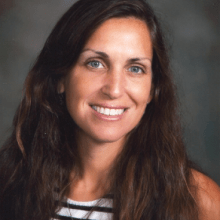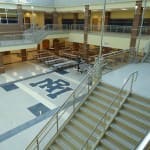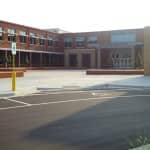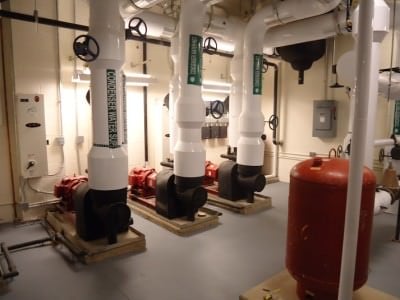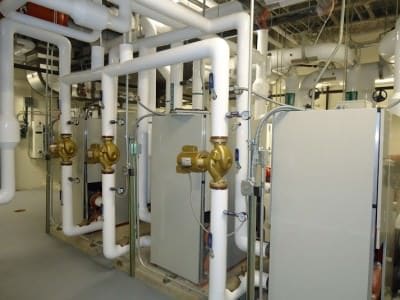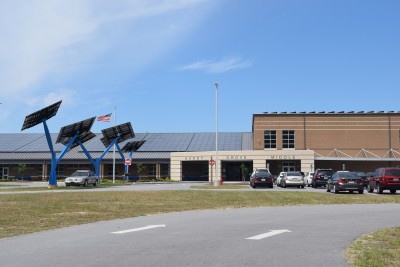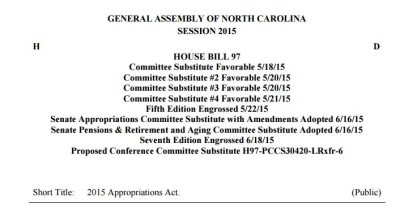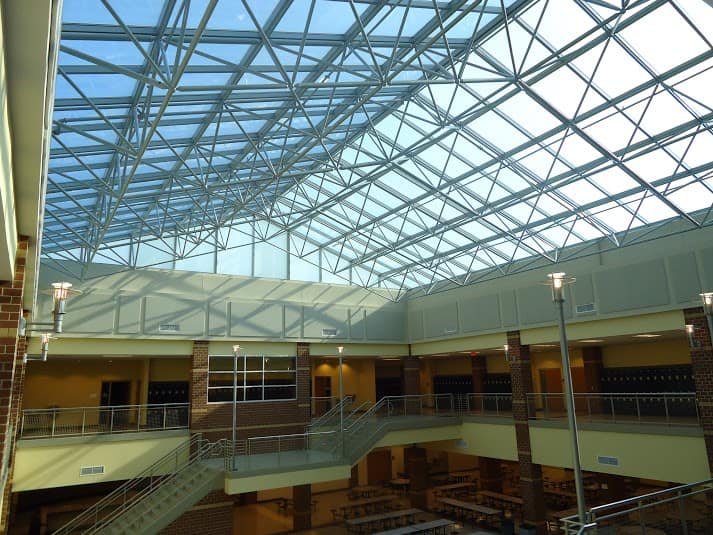

What if your energy company gave you $68 per student per year in your school district?
They might not give it to you, but you can take it back.
Meet Charles Lamm, dubbed Nash County’s “building whisperer,” and the man that led Nash-Rocky Mount Public School’s (NRMPS) utility savings of $11,284,000 over a ten-year period of what he calls, “taking it back.”
Lamm will tell you about his journey. His experience as a hull technician for the Navy, HVAC mechanic, private contractor for an energy management firm, and a school maintenance director, culminating in 2004 when Lamm became Nash-Rocky Mount Public School’s first energy manager.
Lamm learned what it meant to be an energy manager when the Navy assigned him to be a hull technician on the U.S.S. Guadalcanal. He was a plumber, welder, carpenter, maintenance man, and firefighter, but his knack was integrating these skills to save energy. He was living in a closed system in the care of 2,000 U.S. Marines. It was at that time that he realized that energy is a finite resource. Lamm would later say, “All that (ship) had to do was work efficiently so you don’t drain on the ship’s power.”
Lamm understood efficiency contributed to the security of the ship, just as his energy management would one day lead to the betterment of Nash-Rocky Mount’s children.
Fast forward to 2004.
A savvy superintendent and his maintenance director realized the savings potential in energy and drafted Lamm to leave his job as a maintenance director in Lenoir and come home. Lamm would later say, “They gave me carte blanche….I knew if I can save money on a power bill I can give it back to the superintendent for other things.”
And that is precisely what he did.
Cost savings
Over a ten-year period, NRMPS had a 26 percent energy reduction — saving $11, 284,000 — under Lamm’s leadership.
Do the math. That is about $1,128,400 a year divided by their maximum of 16,500 pupils, which equals $68.39 per pupil, per year for ten years! What does that really mean for a teacher? Most teachers are thrilled if they have $300 in instructional funds per year for 100 students or more.
I am an educator. At $68 per pupil, my sixth grade team could purchase every item on our per-pupil budget request — math workbooks ($6), an online reading program ($15), an online math program ($15), and a cursive writing workbook ($6), and still have $20 per pupil leftover for extra Chromebooks, field trips, agendas, and science supplies.
By 2006, six of NRMPS’ 30 schools were Energy Star. In 2012, Nash-Rocky Mount was one of only five N.C. school districts to receive national recognition as an EPA Energy Star Lead Organization. In 2014, NRMPS was recognized as a N.C. Green Ribbon School System just missing the national level recognition. (One year later in 2015 the Chapel Hill-Carrboro City Schools and Cherokee County Schools were the first school systems to receive recognition at the national level with the U.S. Departments of Education’s Green Ribbon.)
Impact on learning
Charles Lamm tells kids, “Learn as much math as you can. Any way the math does. Learn your “goesintas.” Do you know what that is? 2 “goesinta” 4!”
“I use energy management to educate the kids.”
“Basically, I work with the kids not only to help us to reduce energy, but to teach them. Hopefully, one of them will go into the energy field — an engineer or teacher or whatever … it doesn’t matter. I want to spark some interest.”
“Nash Central High had their own Energy Club. … They called me out to help with a project. Now check this out. Now kids think BIG. They are not limited to a budget. They are on a thinking pattern. They decided they wanted all the football lights to come off the grid and put solar power in. Well…we had to come down to reality. They were shootin’ for Mars. In that case they’d take a million dollars to do that and the school system doesn’t have that.”
Instead they replaced the lighting on the walkways from old HP Sodium (high pressure) at 400 kWh to new LED bulbs that used only 175 kWh making the lighting 2.28 times more efficient.
The students raised $4,000 for the project and the remaining budget was matched by NRMPS maintenance funds.
“They were involved in the design alongside a junior architect, building, installing, and reporting. All phases of that project. These students learned how to do a cost-benefit analysis and project cost-savings over time before determining their action.”
Energy management requires data
“It starts with data. You gotta know what an operation should do per kBtu per square foot,” declares Lamm.
He likens energy management to a medical diagnosis, “Know where you are at. If you are ill there are tests to be done.”
He helped EduCon’s Nelson Jessup develop, pilot, and tweak Energy Master Pro Web-Based Energy Tracking Software. Few K-12 schools share energy data because unlike the university system we don’t have to.
In 2002, our state legislature quickly responded to the recession with the Utility Savings Initiative (USI) through the Energy Office in the Department of Environment and Natural Resources (DENR). USI required utilities data reporting and utility reductions with 2015 targets. Unfortunately, it only applies to state-owned buildings — the UNC System, state buildings, and the community college system.
According to the Fiscal Report of USI 2013-2014 ,“total utility expenditures for state agencies and UNC institutions were more than $344 million dollars.”
“If the Utility Savings Initiative had not been in place, taxpayers would have paid an additional $154 million for utilities,” the report noted. “These state facilities avoided emitting an additional 474,708 tons of carbon dioxide air emissions as a result of their energy use reductions.”
The state does not have authority over buildings it does not own.
Our K-12 buildings are under the purview of the county commissioners from 115 school districts and this creates a rabbit hole. Schools are owned by the county, operated by principals and teachers, and supported by NC Department of Public Instruction’s overworked Plant Operations Office. With no state mandate for reporting data, DPI’s Plant Operations Office is the only central agency for K-12 schools. With only seven engineers and one vacancy currently, systematic energy audits are not possible.
The good news is that DPI’s School Planning Office announced in August that it is including utility data in its 2015 Facility Needs Survey. This survey is beginning a new five-year cycle and will require utility data for fiscal year 2014-2015. This survey will not include NC’s 148 charter schools, which serve 64,000 students, but it is a start. Where the county commissioners and the state legislature have no comprehensive K-12 reporting system, DPI’s Office of School Planning is hoping SCHOOLS modify or improve an aspect of their behavior in response to their awareness that they are being observed.
We asked Charles Lamm why county commissioners, superintendents, and school boards should want this data?
“Why not? Why not be a good steward of the funding the taxpayers have provided us?
It’s a common sense thing.”


Trade secrets from an expert
“The one trick is operating buildings and understanding how a building operates. I shouldn’t be giving you all of these secrets because I charge for this stuff now,” says Lamm laughing. He now works as a consultant with EduCon.
“Everything is a triangle like a soccer game. A building needs to work, rest, and needs fuel. You have to watch your buildings day and night to make sure these are balanced.”
Energy priorities:
Rule 1: The people in your system must be comfortable.
Rule 2: See #1.
Management priorities:
- HVAC
- Lighting
- Water/Sewer
“All I know is if a company comes at you with a five-year contract up front, buyer beware….our maintenance office was a lab,” says Lamm. “They will come claiming they have the newest and best product that is better than biscuits and gravy. You got to test it. Get you some free samples.”
“HVAC: Know your temperature, humidity, and dew points. Everyone needs to understand that all three factors play into comfort.”
Lamm makes the following recommendations:
- Building temperature should target 74 degrees.
- EPA recommends humidity 50-55 percent. He says you must keep it under 60 percent.
- He recommends setting back the temperature in the Piedmont to 85 degrees in summer and on weekends. In the coastal region, humidity is a greater concern, he says, and he suggests setting back the temperature to 80.
Benchmarking energy:
Rocky Mount High averaged 28 kBtu/sf/yr. Here is some additional information on targets for net zero building, N.C. averages, and Virginia averages:
